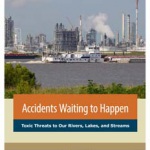Accidents Waiting to Happen
Toxic Threats to Our Rivers, Lakes, and Streams
Chemical plants, manure lagoons, coal ash pits, and other facilities that create potentially harzardous pollution are too often sited next to or nearby our surface waters. This risky practice has resulted in numerous spills of toxic pollution into our waters. We need to better protect our waters from these facilities.
Downloads
Environment Michigan

Clean water is essential to America’s health and welfare. Our lakes, rivers, streams and creeks provide us with water to drink, give character to our most beautiful natural places, and give us places to fish and swim. Yet, across the country, thousands of miles of waterways are threatened by at least one of five major potential sources of contamination: coal ash pits, oil pipelines and trains, fracking wastewater pits, animal waste lagoons, and toxic chemical storage facilities.
The following analysis and review finds thousands of “accidents waiting to happen” across the country, including 31 toxic facilities in flood zones in New Jersey; 170 hog waste lagoons in flood zones in North Carolina; and at least 326 coal ash ponds at coal plants within a quartermile of a waterway. Many of these facilities could, in the event of a spill, devastate the environment and threaten human health.
To protect our waterways, policymakers must reduce our dependence on these inherently risky facilities and stop siting them near the water’s edge. Industrial sites use toxic chemicals that pose longterm threats to the health of humans and wildlife:
• Many industrial facilities use and store harmful chemicals that can damage waterways in the event of an accident. In 2016, more than 21,000 facilities nationwide reported managing 14 million tons of toxic waste – a number likely far lower than all non-waste toxic material stored and used in production processes.
• Recent spills from a wide variety of industrial sites have threatened drinking water and damaged the environment:
º In 2017, a storage facility spilled chemicals into a creek near Roanoke, Virginia, killing tens of thousands of fish.
º In 2017 a steel plant in Portage, Indiana, spilled chromium, a heavy metal, into Lake Michigan, causing a nearby community to shut off its drinking water intake.
º In March 2018, a spill of ferric chloride at a Georgia chicken processing plant killed more than 8,000 fish.
• In New Jersey, which requires facilities to report on hazardous chemical storage, 31 industrial facilities with at least five toxic chemical storage units on site are located in a 100-year flood zone. Of those facilities, 16 are in the heavily populated Newark-Jersey City area across the Hudson River from New York City.
